Chaturthi is the fourth day of Every Fortnight according to Hindu Lunar Calendar.
History
The day on which Shri Ganapati waves descended on earth for the first time is the day on which Shri Ganapati was born, that is, Magh Shukla Chaturthi. Since then, an association between Shri Ganapati and Chaturthi was established.
Shri Ganesh Jayanti
The tithi of Magh Shukla Chaturthi is celebrated as Shri Ganesh Jayanti. Significance of this tithi is that Shri Ganapati Principle is 1000 times more active on this day when compared with other days. The following spiritual experience of a seeker should illustrate how the Shri Ganapati Principle is active on this tithi.
Not knowing that it was Shri Ganesh Jayanti on that day, and yet
chanting automatically the Name of Shri Ganapati during the chanting session
‘On 12th February 2005, it was Shri Ganesh Jayanti; but I was not aware of it. While I was chanting during the scheduled time of 7.30 to 8 a.m., I automatically started chanting the Name of Shri Ganapati. When I became aware of this, I reverted to chanting the usual Name. However, after some time, I again unknowingly switched over to chanting Shri Ganapati’s Name. Then I continued to chant Shri Ganapati’s Name. After the chanting session, I realised that as it was Shri Ganesh Jayanti, and all were expected to chant Shri Ganapati’s Name during the scheduled time. I could infer why I unconsciously switched over to chanting Shri Ganapati’s Name. I expressed gratitude towards the Guru.’ – Mr. Kaustubh Yelegaonkar, Solapur, Maharashtra.
Importance of Chaturthi
1. On the tithi of Chaturthi, the waves of Shri Ganapati and those of the earth match perfectly, and are most conducive to each other. Which means, on the tithi of Chaturthi, a greater proportion of Shri Ganapati waves can reach the earth. Every month, on the day of Chaturthi, Shri Ganapati Principle is 1000 times more active on earth than other days. Worship of Shri Ganapati on this tithi gives greater benefit of Shri Ganapati Principle.
2. Chaturthi is a state beyond the states of jagruti (Awakened), swapna (Dreaming) and sushupti (Deep sleep), that is, turyavastha. Reaching ‘chaturthi’ state is the very goal of a seeker.
3. The Holy text Agnipurana prescribes the vrat (Vowed religious observance) of Chaturthi for acquisition of worldly pleasures and Moksha (Final Liberation).
4. Prohibition on viewing the moon : Looking at the moon on Ganesh chaturthi day is prohibited, because the moon happens to affect the mind, meaning, that which encourages the mind to function. A seeker, on the other hand, aims at dissolution of the mind. In the planetary system, the moon is fickle, meaning, it undergoes phases of waxing and waning; likewise, the mind in the physical body is fickle. Seeing the moon increases the fickleness of the mind by 1/1,00,000 times. Only when the mind becomes thoughtless theturyavastha is attained. On the day of Sankashti, after spending the whole day in performing sadhana (Spiritual practice), the moon is viewed at night. This, in a way, is an indication of the end of the period of sadhana for the day and the mind returning to its involvement in the daily chores.
A story in the Puranas goes thus. Once the moon ridiculed the appearance of Shri Ganapati saying, “How big is your belly, those sifting-pan-like ears, that trunk and those miniature eyes !” Upon hearing this, Shri Ganapati cursed the moon, “Hence forth no one will look at your face. Whosoever does, will attract the consequence of theft”. Sure enough, nobody allowed the moon to come before them. Living in seclusion is impossible. The moon performed austerities, appeased Shri Ganapati and asked for mitigation of the curse. ‘When mitigating a curse, it should not be completely lifted. The curse should also remain in part and its mitigation should also take place. It is not appropriate for me to revoke a curse given by me.’ Thinking thus, Shri Ganapati mitigated the curse by saying to the moon, ”No one will look at you on the day of Ganesh Chaturthi. However, on Sankashti Chaturthi, no one will eat without seeing you”.
Types of Chaturthi
The Chaturthi of the bright fortnight of each month is called Vinayaki and that of the dark fortnight is called Sankashti.
Vinayaki

The ritualistic worship on this day does not include looking at the moon and worshipping it like on Sankashti. Fast the entire day of Vinayaki, and end it the next day. The Deity of this vrat is Shri Siddhivinayak. Vinayaki is performed for all round well-being.
Sankashti

Sankashta means sankat (Calamity). The 360 waves emitting from the core of the earth surround us. These restrict the flows within the body. This itself is known as a ‘sankat’. In the dark fortnight, these 360 waves are active to a greater extent. This restricts the flow of energy through the vessels in our body. Sankashti is performed to overcome this calamity. Shri Ganapati is the God of the 360 waves; hence, worshiping Him helps avoid this calamity.
Fast the whole day. In the evening, after a bath, prepare for the ritualistic worship of Shri Ganapati. At night, after seeing the moon, either an Idol of Shri Ganapati or a betel nut placed on a mound of akshata (Unbroken rice grains smeared with vermillion and used in ritualistic worship), symbolic of Shri Ganapati, should be worshipped with Shodashopachar-puja. Recite the Atharvashirsha twenty-one times. Pay obeisance to the moon after giving an oblation of water and sprinkling gandha (Sandalwood paste), flowers and akshata in its direction. On the day of Chaturthi, the oblation of water should be made in a tamhan (Metal dish). We should eat only after offering Mahanaivedya, which consists of five delicacies. The Deity of this vrat is Shri Vighnavinayak.
Angaraki
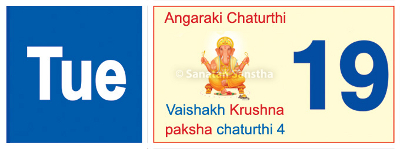
The Chaturthi, which comes on a Tuesday is called Angaraki. Angar means the planet Mars or land. Shri Ganapati is the presiding Deity of Mars as well as the earth. Shri Ganapati as well as Mars have the same complexion. On the day of Angaraki, Shri Ganapati waves reach the earth in a greater proportion and those from Mars too reach the earth. Consequently, most of the waves emitting from the moon are destroyed. Hence, the benefit derived by performing Angaraki Vinayaki and Angaraki Sankashti is equivalent to that of performing the Vinayaki and Sankashti throughout the year.
Angaraki, unlike other vrats, is not performed throughout the day and night. It is an observance which lasts five prahars (One prahar is approximately 3 hours), four during the day and one at night. According to the ritual, a meal should be taken at moonrise. Thus, that meal becomes a part of the ritual and is not partaken to conclude the fast.
Shri Ganesh Chaturthi
Significance
The destructive and Tama-predominant Yama waves reach the earth in greater proportion in the 120 days from the Ashadha Pournima to Kartik Pournima. Their intensity is greater in this period. However, in this period of greater intensity (meaning, the period from Bhadrapad Shukla Chaturthi to Bhadrapad Shukla Chaturdashi [or Anantachaturdashi]), the Shri Ganapati waves too reach the earth in greater proportion. It helps reduce the intensity of the Yama waves.
On Shri Ganesh Chaturthi, as also during the days of Ganeshotsav, Shri Ganapati Principle is 1000 times more active on the earth. Worship of Shri Ganapati in this period bestows greater benefits.
In a family, who should celebrate Shri Ganesh Chaturthi ?
The vrat undertaken during Shri Ganesh Chaturthi is known as the ‘Siddhivinayak vrat’. Ideally, it should be performed in all the families. If all the brothers in a family live together, that is, they have a common treasury and kitchen, they can all worship one Idol. However, if for some reason the treasury and kitchen are separate, then each one should worship Shri Ganapati independently in his own portion of the house.
Question : If the treasury and kitchen are separate, spiritual science says that each one should worship Shri Ganapati independently. However, as per the family tradition in some families, only one Shri Ganapati Idol is worshipped. In these houses, it is found that every year Shri Ganapati is worshipped by turn in the house of a different brother. Is it correct ?
H.H. Dr. Athavale : If the family tradition or the firm belief to worship only one Idol is not to be broken, then it is most appropriate that the Idol be worshipped in the house of the brother who has maximum spiritual emotion.
Need for a new Idol
Despite having an Idol of Shri Ganapati for day-to-day worship, the reason for bringing a new Idol for Shri Ganesh Chaturthi is as given here. In the period of Shri Ganesh Chaturthi, Shri Ganapati waves reach the earth in greater proportion. If these waves are invoked in the same Idol of worship, then the Idol will imbibe a tremendous amount of energy. It is difficult to worship such an Idol in meticulously abiding by all the norms of karmakanda throughout the year. Hence, a new Idol is installed to invoke the Shri Ganapati waves and is then immersed in flowing water. The proportion of Sattva, Raja and Tama components in Shri Ganapati waves is 5:5:5 while that in an average person is 1:3:5. This makes it difficult for an average person to imbibe Shri Ganapati waves over a long period.

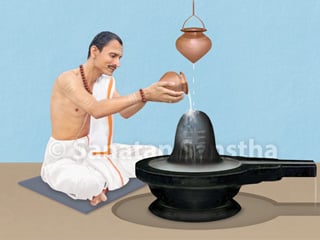 Mahashivratri 2024
Mahashivratri 2024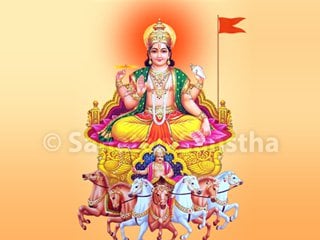 Ratha Saptami 2024
Ratha Saptami 2024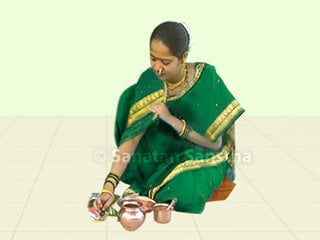 Importance of Adhik maas (Purushottam maas)
Importance of Adhik maas (Purushottam maas)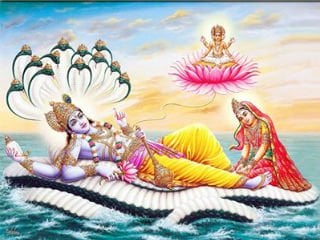 Vaikunth chaturdashi is an invaluable opportunity granted to us to worship Deity Shri Vishnu
Vaikunth chaturdashi is an invaluable opportunity granted to us to worship Deity Shri Vishnu How to celebrate Navaratri in adverse times caused by coronavirus pandemic ?
How to celebrate Navaratri in adverse times caused by coronavirus pandemic ?